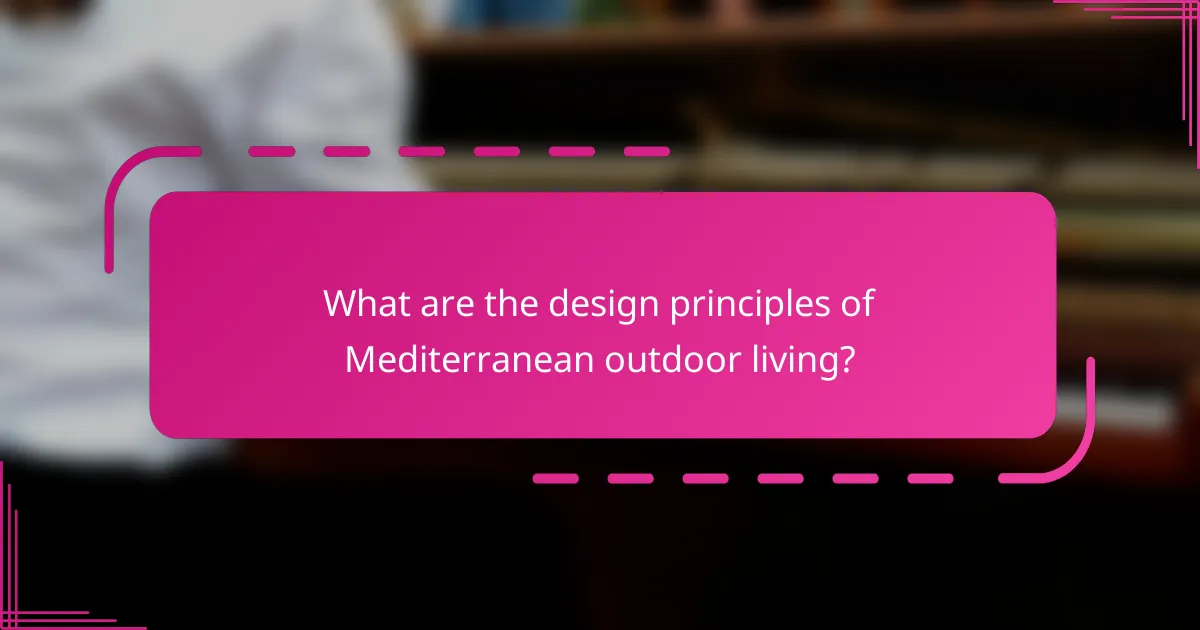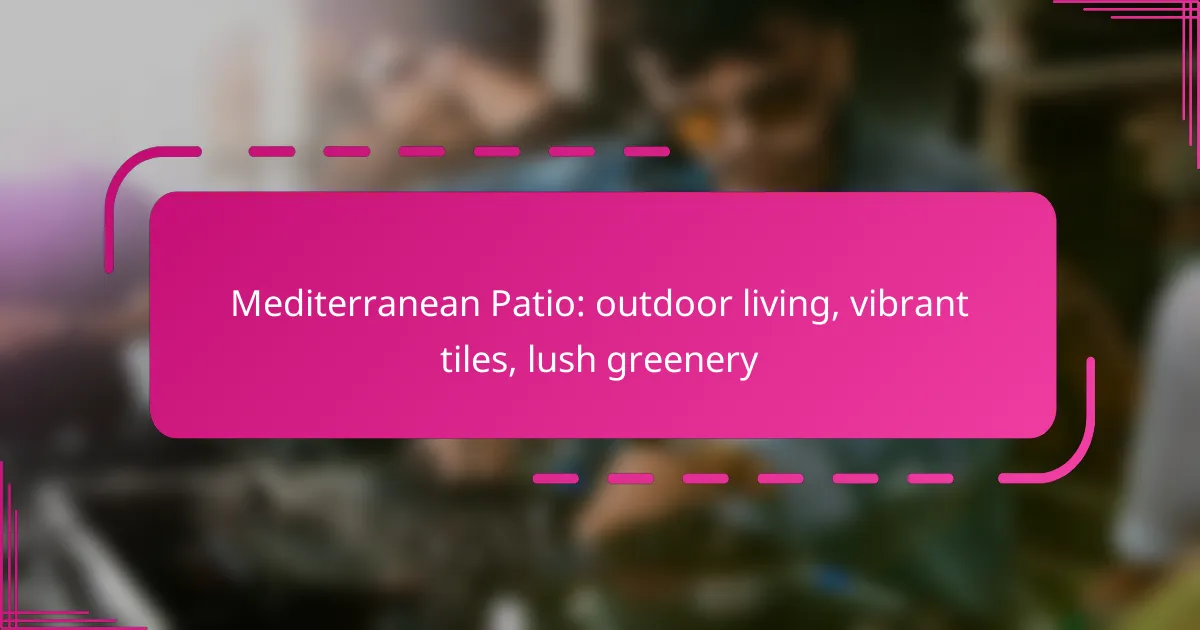A Mediterranean patio is a perfect blend of vibrant tiles, lush greenery, and comfortable outdoor furniture, creating an inviting space that embodies the essence of outdoor living. By incorporating drought-resistant plants like olive trees and lavender, along with colorful terracotta or ceramic tiles, you can transform your patio into a serene retreat that reflects the warm, relaxed lifestyle of the Mediterranean.

How to create a Mediterranean patio in Los Angeles?
To create a Mediterranean patio in Los Angeles, focus on vibrant tiles, lush greenery, and comfortable outdoor furniture. Incorporating these elements will help you achieve a warm, inviting space that reflects the Mediterranean lifestyle.
Incorporate vibrant tiles
Vibrant tiles are a hallmark of Mediterranean design, often featuring intricate patterns and bright colors. Consider using ceramic or terracotta tiles for your patio flooring or as accents on walls and tables. Popular colors include blues, greens, and earthy tones that evoke the coastal landscapes of the Mediterranean.
When selecting tiles, ensure they are suitable for outdoor use to withstand the Los Angeles climate. Mixing different tile patterns can create a unique and lively atmosphere, so don’t hesitate to experiment with various designs.
Add lush greenery
Lush greenery is essential for a Mediterranean patio, providing a sense of tranquility and connection to nature. Incorporate a variety of plants such as olive trees, lavender, and bougainvillea, which thrive in the Los Angeles climate. Consider using pots and planters in vibrant colors to enhance the aesthetic.
To maintain a lush appearance, choose plants that require minimal water and are drought-tolerant. Grouping plants with similar care needs can simplify maintenance while creating a visually appealing arrangement.
Choose comfortable outdoor furniture
Comfortable outdoor furniture is crucial for enjoying your Mediterranean patio. Opt for pieces made from durable materials like wrought iron, teak, or weather-resistant wicker. Cushions in bright fabrics can add comfort and style, making your space inviting for relaxation and social gatherings.
Arrange seating in a way that encourages conversation, such as a circular or semi-circular layout. Don’t forget to include a dining area for alfresco meals, which is a key aspect of Mediterranean living.
Utilize shade structures
Shade structures are important for creating a comfortable outdoor environment in Los Angeles. Consider installing pergolas, awnings, or shade sails to protect your patio from the sun. These structures can also serve as a focal point and enhance the overall design of your space.
When designing your shade structure, think about incorporating climbing plants like grapevines or jasmine to add greenery and create a more immersive experience. This not only provides shade but also enhances the Mediterranean ambiance.
Incorporate water features
Water features can significantly enhance the atmosphere of your Mediterranean patio. Consider adding a small fountain, pond, or even a decorative birdbath to create a soothing sound and attract wildlife. The gentle sound of flowing water can provide a calming backdrop for your outdoor space.
When selecting a water feature, ensure it complements the overall design and scale of your patio. A well-placed feature can become a stunning centerpiece, drawing attention and adding to the serene environment you aim to create.

What are the best plants for a Mediterranean patio?
The best plants for a Mediterranean patio are those that thrive in warm, dry climates and can withstand periods of drought. Key choices include olive trees, lavender, succulents, and citrus trees, each offering unique benefits and aesthetic appeal.
Olive trees
Olive trees are iconic in Mediterranean landscapes, known for their gnarled trunks and silvery leaves. They require full sun and well-drained soil, making them ideal for patios that receive plenty of light. Regular pruning helps maintain their shape and encourages healthy growth.
Consider planting them in large pots or directly in the ground if space allows. They can grow quite tall, so ensure you have enough vertical space. Olive trees are also drought-resistant, which can reduce your watering needs during hot months.
Lavender
Lavender is a fragrant herb that adds vibrant color and a pleasant aroma to your patio. It thrives in sunny spots with well-drained soil and is highly drought-tolerant once established. This makes it a low-maintenance option for outdoor living spaces.
In addition to its beauty, lavender attracts pollinators like bees and butterflies, enhancing the biodiversity of your patio. Regular pruning after flowering helps to keep the plants bushy and encourages more blooms in the following season.
Succulents
Succulents are perfect for a Mediterranean patio due to their ability to store water in their leaves, making them incredibly drought-resistant. They come in a variety of shapes, sizes, and colors, allowing for creative arrangements in pots or garden beds.
When choosing succulents, opt for varieties that thrive in full sun, such as Echeveria or Sedum. Ensure that the pots have drainage holes to prevent root rot, and consider grouping them for a striking visual impact.
Citrus trees
Citrus trees, such as lemon and orange, can thrive in Mediterranean climates and provide both beauty and fruit. They require plenty of sunlight and well-drained soil, and they benefit from regular watering during dry spells.
These trees can be grown in pots, making them versatile for patios. Keep in mind that they may need protection from frost in cooler months, so consider bringing potted trees indoors during winter if you live in a region with colder temperatures.

What tile options are popular for Mediterranean patios?
Popular tile options for Mediterranean patios include terracotta, ceramic, and hand-painted tiles. Each type offers distinct aesthetic and functional benefits, making them suitable for creating vibrant outdoor living spaces.
Terracotta tiles
Terracotta tiles are a classic choice for Mediterranean patios, known for their warm, earthy tones. These tiles are made from natural clay and are often unglazed, providing a rustic look that complements lush greenery.
When selecting terracotta tiles, consider their thickness and porosity. Thicker tiles are more durable and better suited for outdoor use, while porous tiles may require sealing to prevent water damage. Regular maintenance, such as cleaning and resealing, can extend their lifespan.
Ceramic tiles
Ceramic tiles are another popular option, offering a wide range of colors and patterns. They are typically glazed, which makes them more resistant to stains and moisture, ideal for outdoor environments.
When choosing ceramic tiles, look for options rated for outdoor use to ensure they can withstand temperature fluctuations and moisture. Additionally, consider slip resistance to enhance safety in wet conditions.
Hand-painted tiles
Hand-painted tiles add a unique artistic touch to Mediterranean patios, featuring intricate designs and vibrant colors. These tiles can serve as focal points or accents in your outdoor space.
While hand-painted tiles are visually appealing, they may require more care than other types. Ensure they are sealed properly to protect against fading and wear. Incorporating them in smaller areas, like borders or tabletops, can help maintain their beauty while minimizing maintenance.

How to maintain a Mediterranean patio?
Maintaining a Mediterranean patio involves regular upkeep to preserve its vibrant tiles and lush greenery. Key tasks include cleaning surfaces, caring for seasonal plants, and sealing tiles to protect against wear and weathering.
Regular cleaning
Regular cleaning is essential to keep your Mediterranean patio looking fresh and inviting. Sweep or use a leaf blower to remove debris, and wash surfaces with a mild detergent to prevent stains and algae growth.
For tiled areas, consider using a pressure washer occasionally to remove stubborn dirt. Avoid harsh chemicals that can damage tiles or plants, opting instead for eco-friendly cleaning solutions.
Seasonal plant care
Seasonal plant care is crucial for maintaining the lush greenery typical of a Mediterranean patio. In spring, focus on planting and fertilizing, while summer requires regular watering and pruning to promote healthy growth.
During fall, prepare plants for cooler weather by trimming back dead foliage and applying mulch. In winter, protect sensitive plants from frost by covering them or moving pots indoors if necessary.
Tile sealing
Tile sealing helps protect your patio’s vibrant tiles from stains and moisture damage. It’s advisable to seal tiles every few years, depending on the type of tile and the level of foot traffic.
Choose a high-quality sealant suitable for outdoor use, and apply it according to the manufacturer’s instructions. This preventive measure can extend the life of your tiles and maintain their appearance over time.

What are the design principles of Mediterranean outdoor living?
Mediterranean outdoor living emphasizes a harmonious blend of natural elements, open spaces, and a connection to the surrounding environment. Key principles include the use of natural materials, airy layouts, and seamless integration with nature to create inviting and functional outdoor areas.
Emphasis on natural materials
Natural materials are central to Mediterranean design, often featuring stone, wood, and clay. These elements not only enhance aesthetic appeal but also provide durability against the elements. For example, terracotta tiles and wooden beams can create a warm, rustic feel while ensuring longevity.
When selecting materials, consider locally sourced options to reduce environmental impact and support regional craftsmanship. Using natural finishes, such as lime wash or oil-based stains, can further enhance the organic look of your outdoor space.
Open and airy layouts
Open layouts are essential in Mediterranean outdoor living, promoting a sense of spaciousness and flow. This can be achieved through large patios, expansive terraces, and minimal barriers between indoor and outdoor areas. Incorporating large windows and sliding doors allows for natural light and easy access to outdoor spaces.
To maintain an airy feel, opt for lightweight furniture and avoid overcrowding with decor. Arrange seating to encourage conversation and relaxation, ensuring that pathways remain clear and inviting.
Integration with nature
Integrating outdoor spaces with the surrounding landscape is a hallmark of Mediterranean design. This can involve planting native flora, creating garden beds, or installing water features that attract local wildlife. Such elements not only enhance beauty but also foster biodiversity.
Consider using vertical gardens or trellises with climbing plants to maximize space and create a lush environment. Additionally, incorporating shaded areas with pergolas or awnings can provide comfort while allowing you to enjoy the natural surroundings.
